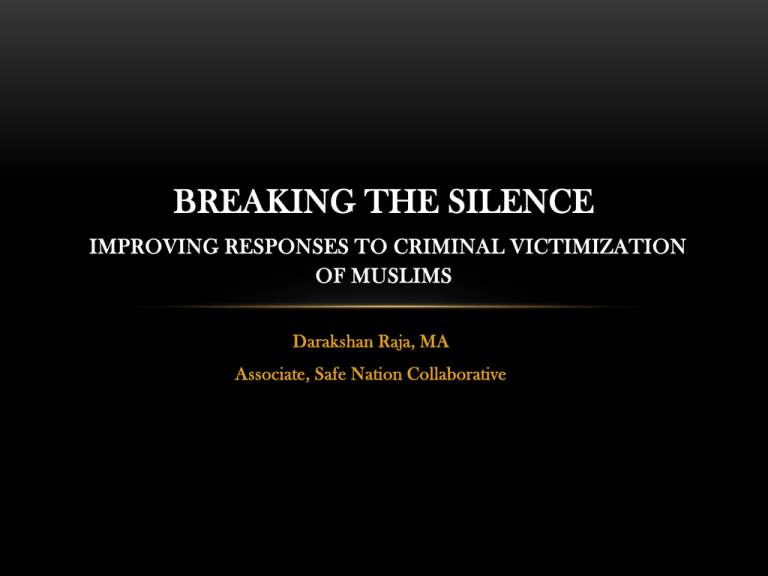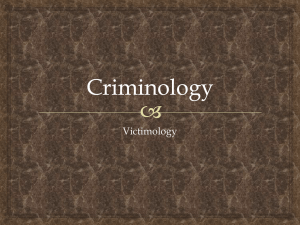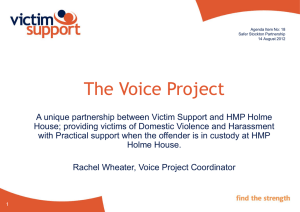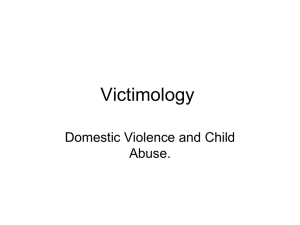
BREAKING THE SILENCE
IMPROVING RESPONSES TO CRIMINAL VICTIMIZATION
OF MUSLIMS
Darakshan Raja, MA
Associate, Safe Nation Collaborative
ACKNOWLEDGEMENTS
Development of this training module was supported by funding from Safe Nation Collaborative. The opinions, findings, conclusions
and recommendations expressed in this training are those of the author and do not necessarily reflect the position of Safe Na tion
Collaborative or the various organizations and individuals that were interviewed in order to develop this training.
Overall 23 community leaders and professionals who have been working with Muslims who are victims provided feedback for this
training. There were a mix of different perspectives from Chaplains, Imams, law enforcement officers, professionals within po licy and
civil rights organizations, and mental health professionals that have worked with Muslims across a wide range of crimes spann ing from
domestic violence, hate crimes, sexual assault, forced marriages, workplace violence to torture. Development of this training would not
have been possible without the critical feedback from the following individuals:
Sergeant Mike Abdeen, Founder of Muslim Community Affairs Initiative, Los Angeles Sherrif’s Department
Sakeenah Abdulraheem, Counselor and former employee of CAIR
Alejandro Beutal, Former MPAC Government and Policy Analyst
Anas Coburn, Founder and Managing Director, Project Sakinah
Asma Hanif , Founder & Director, Muslimaat al-Nisaa
Shazia Kamal, Associate Editor at AltMuslimah.com and former MPAC Hate Crimes Specialist
Imam Mohamed Magid, President, Islamic Society of North America
Muhammad Malik, Human Rights Advocate, Former Executive Director at CAIR and Board Member of No More Tears
Morlie Patel, Deputy Director of External Affairs, Cook County Sherriff’s Department
Ibrahim Ramey, Executive Director, Muslim Women in Research and Development (MWIRD)
Qudsia Raja, Policy & Advocacy Field Director, YWCA USA
Peaceful Families Project (National Coalition on Muslims against Domestic Violence)
“While the trauma and harm experienced by many victims of crime is deep,
debilitating, and long-lasting, our treatment of crime victims at every level-individual, community, and governmental is ineffective, fragmented, and
dismissive. This woefully inadequate response reinforces victims’ sense of shame
and isolation, and a misguided belief that recovery is a private manner (Herman,
2010).”
OBJECTIVES
Provide an overview of victimization within the Muslim community
What separates the needs of Muslims who are victims of crime from
other victims of crime
Identify challenges and barriers for Muslims who are seeking victim
services or help from the criminal justice system
Provide recommendations and resources for promising practices
AUDIENCE
How many of you work with victims of crime?
What types of crimes?
Have you had training on working with victims of crime? What types
Have you worked with Muslims who have been victims of crime?
I. Victimization in America
HISTORY & LEGISLATION
Victim’s Rights
Movement Began
in the 1970s(40
years of
developments)
Victims of Crime
Act (VOCA)-1984
•Established strong
federal leadership on
assisting victims
(Crime Victims
Compensation Fund)
Violence Against
Women Act
(VAWA)-1994
Crime Victims’
Rights Act
(2004)
•Considered the
lifeline of providing
services to women
escaping violence
•Enhanced
protections for
victims within the
federal system
TYPES OF CRIMES
Campus Crimes
Child Victimization
Dating Violence
Domestic/Intimate Partner Violence
Drunk and Drugged Driving
Elder Victimization
Hate and Bias Crime
Homicide
Human Trafficking
Identity Theft/Financial Crimes
Internet Victimization
School Crime and Victimization
Sexual Violence
Stalking
Teen Victimization
Terrorism
Workplace Violence
PREVELANCE OF CRIME AND VICTIMIZATION
18.7 million violent and property crimes for individuals aged 12 and over
(National Crime Victimization Survey)
Property Crimes: 14.8 million crimes
Assault: 3,148,250 million crimes
Intimate Partner Violence
a) Male: 101, 530
b) Female: 407, 700
Rape/Sexual Assault: 188,380
Homicide: 12,996 (FBI UCR data for 2010)
Hate Crimes: 7,783 hate crimes (FBI UCR data from 2008)
REPORTING TO LAW ENFORCEMENT
52% of all violent victimization crimes aren’t reported to law
enforcement (NCVS, 2012)
16%: police wouldn’t help/couldn’t help (Doubled since 1994)
13%: fear of reprisal or getting into more trouble
62% of victimization that took place at the hands of a non-stranger
wasn’t reported
76% of all violent crimes that occurred at schools were not reported
12-17 is the age group with the most underreporting for victimization
for violent crimes
VICTIM SERVICES
From 1993-2009 only 9% of all victims of violent crime received
assistance(NCVS, 2012)
Domestic Violence/Intimate Partner Violence: 23%
Rape/SA: 21%
Aggravated Assault: 9%
Robbery: 8%
Simple Assault: 7%
Property Crime: 2%
II. Underserved Groups:
Victimization and Muslims
MUSLIM COMMUNITIES IN AMERICA
Population: 2.6 million to 6.2 million in 2030 (Pew Research Center
Forum on Religion and Public Life, 2009)
65% percent of U.S Muslims are foreign born (Pew Research Center,
2007)
35% are Native-born Muslims (Pew Research Center, 2007)
Highest Concentration: Los Angeles, New York, Chicago, and Texas
(Abdelatif & Minnite, 2002)
RESEARCH ON MUSLIM COMMUNITIES
Most research on Muslims and the largest amount of funding has
focused on the threat of extremism and terrorism
Handful of studies on Muslims as victims of crime
Lack of awareness that Muslims aren’t a homogeneous group
Lack of awareness or acknowledgement that victimization within the
Muslim community exists and how it may look different from
victimization in general within America
FORMS OF VICTIMIZATION EFFECTING MUSLIM COMMUNITIES
Domestic Violence
Honor Based Violence
(Honor Killings)
Gender Based
Violence (FGM, Early
Childhood marriages,
Acid Violence, human
trafficking)
•Forced Marriages (Not considered a crime under US law)
•In-Law Violence
•Dowry Violence
•Federal Bill in the process of being passed in 2012 that aims to
track victims of HBV but it isn’t a crime under US law. There are
no screenings in place
•Protections may exist for undocumented women through TVisas/U-Visas or through seeking asylum. However there are weak
protections, lack of clear protections or no protections against these
forms of violence, or even an acknowledgement that such forms of
violence exist against American women who are citizens
CONT.
Islamophobia
Political
Violence
•Religious and Racial Discrimination
•Hate Crimes
•Domestic Terrorism
•Post 9/11 War on Terror Policies (Indefinite Detention, disappearances,
torture, enhanced interrogation, racial profiling, increased surveillance and
monitoring)
•Victims of Oppressive or Authoritarian Governments (political prisoners,
police brutality)
•Victims of War Crimes and conflict zones (torture, use of rape as a weapon of
war, human trafficking, genocide, ethnic cleansing, military occupations)
•May see this more within the refugee or immigrant community
HATE CRIMES
“A hate crime, also
known as a bias crime,
is a criminal offense
committed against a
person, property, or
society that is
motivated, in whole or
in part, by the
offender’s bias against
a race, religion,
disability, sexual
orientation, or
ethnicity/national
origin (FBI).”
•Prevalence: 1600% increase
in anti-Muslim hate violence
after 9/11 (Southern Poverty
Law Center, 2012)
•Underreporting is an issue
and certain forms of hate
violence against specific
religious groups isn’t collected
(Sikhs)
•Free Speech v. Hate Speech
•Local law enforcement
agencies aren’t trained on
identifying what to look for
and the federal government
will take only the worst of the
worst cases
Domestic violence is a pattern of abusive behaviors used by
someone to establish power and control over another person
in a relationship. Domestic violence sometimes follows a
cyclical pattern in which there are periods of calm, building
up of tension, and then abuse. After a period of abuse,
batterers are often apologetic, but as the cycle repeats the
abuse usually gets worse over time (Peaceful Families
Project).”
PREVALENCE OF DOMESTIC VIOLENCE
First National Study: 10% of Muslims experienced abuse in their
homes (Alkhateeb, 1999)
Largest study (Celik & Sabri, 2012)
N=801 Muslim respondents
66% reported they knew someone who was being abused (2/3)
53% reported they themselves had experience abuse (1/2)
Comparable to the highest rates of victimization of minority
groups in America
DOMESTIC VIOLENCE (CONT.)
Duluth Model
Cultural Abuse
•Dowry Violence
•In-Law Violence
Abuse of Immigration Status
•Study in NYC had found 51% of
all intimate partner homicide
victims were foreign-born(New
York City Department of Health
and Mental Hygeine, 2004)
Economic Abuse
Physical Abuse
(Kicking, hitting,
shoving)
Sexual Abuse (rape,
sexual assault,
forced prostitution,
interfering with birth
control-controlling
reproductive health)
Emotional Abuse
(shouting, namecalling)
Psychological Abuse
DOMESTIC VIOLENCE AND RELIGIOUS ABUSE
Coercion and Threats
Threatening to marry another wife and “God ordained wife-beating (4:34)”
Threatening to spread the word and dishonor her reputation
Making her drop charges to preserve the extended family’s honor
Intimidation
Having the Imam tell the wife its her fault
Collecting/Displaying weapons
Stalking
Emotional Abuse
Telling the victim she isn’t a good Muslim mother or wife
Stating her knowledge of Islam is weak
Telling women they need to be obedient and uphold the honor of the family
DOMESTIC VIOLENCE AND RELIGIOUS ABUSE
Isolation
Restricts movement and access to family
May use religious explanations stating he is the manager of the family and has God-given
right to control her movement
Minimizing, Denying and Blaming
Saying the wife caused the abuse
Telling the wife that by telling others of the abuse she is violating the husband’s privacy and
God will punish her
Using Children
Child Abuse for the purposes of not having kids become too American or Western
Threats of taking the children back to the native country to marry them off or kidnap them
Father encourages children to abuse and disrespect the mother
HONOR BASED VIOLENCE (HBV)
Video Clip: http://vimeo.com/43619478 (First 3 minutes)
HBV versus DV(Honor Based Violence Awareness Network, 2012)
Collective nature of the crime
Multiple perpetrators (family, extended family, community)
Possibly multiple victims
Strong correlation with forced marriages
Male/Female can be the victim or perpetrator in the crime
Honour Killings
“An ‘honour’ killing is the most extreme form of HBV where the supposed offender against
family ‘honour’ is killed to restore the ‘honour’ which has supposedly been lost through her
behavior; however there are other lesser responses, such as forcing marriage, or other forms of
violence which may also be expressed(Honor Based Violence Network, 2012)”
Currently HBV isn’t being monitored or tracked in the United States. There is also currently
nothing explicit within laws that protects from HBV. US is beginning and has introduced a federal
bill that will track HBV in the United States
FORCED MARRIAGES
Prevalence: 3000 suspected cases in the United States (Tahirih Justice Center,
2011)
85% identified as Muslim
India, Pakistan, Mexico, and Bangladesh had the highest numbers of
reported or suspected cases of forced marriages
Forced Marriage v. Arranged Marriage
Lack of consent or the ability to give consent (Child Marriages, incapacity,
vulnerability)
It can happen to men and women at any age, and it may have taken place either
within the United States or abroad
Subject to Force, Fraud, or Coercion
No US law against forced marriage
FEMALE GENITAL MUTILATION (FGM)
Collective name for various traditional practices of cutting the female genitals that
usually occur from 4-12 in girls, and are considered a rite of passage(Center for
Productive Rights, 2006).
Usually carried out by a woman
Cultural not Religious Practice but prevalent in some few subsets of Muslim
communities
FGM is not illegal in all states in the United States
No prevalence on how many American women face FGM
IMPACT OF CRIME VICTIMIZATION
Trauma (PTSD)
Secondary Victimization (Societal Response or Lack of)
Victim Blaming and Shaming
Ostracizing the victim due to stigma
Self-Harm/Suicide
Vulnerability to further victimization(Poly
More crime(While most victims of crime do not offend, the majority of offenders
have had severe experiences of victimization within their lives)
III. Current State of Response
to Victimization of Muslims
WHERE ARE MOST MUSLIMS SEEKING
SERVICES AFTER BEING VICTIMS OF
CRIME?
Mosques:
Most Muslims
are seeking
counseling
and advice
from Imams
within
mosques
•The role of Imams as central to
counseling was found in a study
conducted
in New York City of
22 mosques where 96% of the
participants in the study considered
the Imam a counselor, and 74% had
sought out counseling from imams
on safety issues(Abu-Ras, Gheith, &
Cournos, 2008)
TYPES OF CRIMES NGOS PRIMARILY SERVING
MUSLIMS ARE SEEING (LIST OF TOP CRIMES)
Domestic Violence/IPV/HBV
Hate Crimes/Racial Discrimination
Child Abuse
Forced Marriages
Sexual Assault
Dating Violence
Employers abusing low-wage employees (sexual harassment, unpaid
wages, assault, etc)
Human Trafficking
VICTIM SERVICES RESPONSE TO MUSLIMS
Victim Services for Muslims is within the embryonic stage
Fear of Reaching Out to Victim Services
Importance of having faith based services
Faith matters and maybe the only thing the victim may have
VICTIM SERVICES RESPONSE TO MUSLIMS
Lack of professional services
Lack of adequate and appropriate services
Lack of funding and support for organizations working with Muslims
Challenges: There is a divide between the Muslim Social Workers and
those that are conducting work through the social work lens versus the
traditional religious lens
CHALLENGES AND BARRIERS IN ADDRESSING
VICTIMIZATION
“The Muslim community is
30 years behind awareness
and the acknowledgement of
victimization (Interviewee).”
• Lack of awareness in the
Muslim community of
victimization
• (Sexual Assault/Domestic
Violence/IPV/Human
trafficking/Child
Abuse/Elder Abuse)
“Just now beginning to accept
the idea that Muslims can be
and are indeed victims of
crime (Survey Respondent).”
• Lack of awareness and
education that victims have
rights under the criminal justice
system
• Lack of awareness on types of
services and how to access them
• Racial and Ethnic Divisions
CHALLENGES AND BARRIERS IN ADDRESSING
VICTIMIZATION (CONT.)
Denial that victimization
exists within the community
Honor
•Emphasis on the community versus the individual (reputation)
•Fear of making Islam/community/culture/family look bad
Cultural Stigma around
victimization
Shame
•Isolated from the Community due to Stigma
Generations of Post-Trauma •Polyvictimization
and Abuse
CHALLENGES AND BARRIERS
(IMMIGRATION CONCERNS)
Status (Fear of Deportation)
Less Protection Under the Law
Less access to services and victim’s rights
Language Barriers
Fear law enforcement will not believe the individual has
been victimized
CHALLENGES AND BARRIERS (SPECIFIC TO DV)
Culture v.
Religion
• Cultural practices have been mixed with religious
interpretations.
•“Not supportive and may hinder an investigation or prevent victims
from seeking professional services”
Mosques
•Ex: There have been some mosques where the funding boards
have asked that their mosque shouldn’t work with any victim of
DV within the community because it would break homes.
•Ex: A pattern of behavior in all cases of dv where when the spouse
is about to report the abuse and the abuser is aware of that, the
perpetrator or their family will increase donations to the mosque
because then the mosque won’t speak out or the Imams. “ You
won’t bite the hand that feeds you (Interviewee)”
CHALLENGES AND BARRIERS
(SPECIFIC TO DV)
Denial Among Imams
Estimation of how many Imams give sound support for domestic
violence
“20% get it but the other 80% just don’t think about it and most
of it just doesn’t get reported (Interviewee)”
“I personally know a woman whom was being abused and her
child was born ill due to it. He is now dead. No one listened to
her. No one believed her and now her son is dead and she is
devastated. I know women who have miscarriages due to the
abuse (Survey Respondent)” Referring specifically to the Imam and the
Mosque
DV(CONT.)
Lack of Knowledge on the Danger Victims are In
“90% of Imams tell women to go back home. They are signing these women’s
death warrants. In 100% of the cases where women listened to the Imam, I
never heard from them again (Director, Muslim Women’s Shelter)”
Many Imams aren’t aware of the rights of victims under the criminal justice
system
(Eg : Won’t know about orders of protections or restraining orders).
“50% of Imams don’t have knowledge on the criminal justice system and rights
for victims of crime. 90% won’t know the difference or the purpose of orders
of protection.”
WOMEN
Invisibility in terms of voices and presence within the
religious community
Traditional roles of women that include not being in
public/Conditioned to not leave the home
Stereotypes of the Hijab
Sex related crimes: Women are reluctant to report because
of honor norms. To report would be to violate the family’s
honor
Divorce is Taboo(DV)
MEN
Shame
No resources for addressing male victimization
Many organizations specifically have within their mandates
that they will not serve males
Victimization of men occurring outside the home
Sexual Abuse: “We are hearing scattered reports in the
country that there is the existence of sexual abuse occurring at
the hands of religious teachers (Interviewee)”
CJ RESPONSES TO MUSLIMS (LAW ENFORCEMENT)
Fundamental misunderstanding of the function of the
different LE agencies
Mistrust of LE
Fear of LE
Victims won’t be believed (More heightened perception
among immigrants)
LAW ENFORCEMENT
Not aggressive enough in cases where the victims are Muslim
Misconception that the faith allows for the abuse.
Ex: Incidents where officers have responded and stated “Isn’t he
allowed to beat you? “Why are you calling us.”
Hate Crimes: “Lukeworm response to hate crimes.” Agencies don’t
know what characteristics to look for in terms of indicators of bias
Forced Marriages/Honor Based Violence: Don’t know what to look
for in terms of indicators
CJ RESPONSES TO MUSLIMS (PROSECUTION)
Low Prosecution Rates
Domestic Violence: Rarely seen cases prosecuted. Some participants
mentioned they haven’t heard of a single case that was prosecuted.
Even if they are, sentences are low, and the individual will be released
back into society and can abuse someone else.
Hate Crimes: Some prosecutions on a federal level but most cases on
the state level are being prosecuted as property crimes unless there was
an assault
Property Crimes/Financial Crimes: Few prosecutions occurring
CJ RESPONSES TO MUSLIMS (JUDGES)
“There are instances where women’s faith has been used against them.
There is a disconnect with courts and victims who are women of faith and
victims have been denied orders of protection because the judge felt the
victim wasn’t serious enough (Inteviewee).”
Lack of awareness and understanding of religion and culture
Lack of sensitivity
Judges are making decisions based on their own religious
interpretations
IV. Recommendations for Improving
Responses to Muslims who are Victims of
Crime
RECOMMENDATIONS FOR IMPROVING
SERVICES
Unlearn Biases and
Stereotypes
Understanding the
Importance of Honor
in the Community
PROMISING PRACTICES OF ENGAGING THE
MUSLIM COMMUNITY (LAW ENFORCEMENT)
Improve Outreach
to the Muslim
Community
•Attend and table at community events
•Attend the mosque
•Build Relationships with various leaders and professionals in
the community
•Work with Advocates
•DO NOT USE THE SAME PEOPLE FOR WORKING
WITH ALL TRYPES OF CRIMES
Cook County Sheriff’s
Office and Los Angeles
Sherriff’s
Department(Promising
Models of Engagement)
•Used the officers within their agencies who were trusted
officers and had validity within the community
•Created materials to educate officers on cultural competency
•Created trainings on issues such as domestic violence and
elder abuse and are conducting outreach in the community
•Taken clear positions that anything that rises to the level of a
crime will be handled as such (LASD)
CONT.
Encourage LE agencies
to create such initiative
Overall community is
receptive to such
initiatives because they
want their voices heard
LASD is willing to serve
as a resource to other
law enforcement
agencies on how to
create similar initiatives
engaging the Muslim
community in other
jurisdictions. They have
already worked with
SDPD, LAPD, MPD,
and others. Every
community differs and
the needs are different.
USING THE COMMUNITY AS A RESOURCE
Faith-Based Community
Taskforce
Working with several
different community
members because issues
may present a challenge
and one Imam or
community member cannot
address them all
• Leverage the
community
• Have a directory and
network of Imams
FRAMING THE DIALOGUE ON HOW TO WORK
WITH VICTIMS
Victim Blaming
Do not hold the religion or
culture accountable. There is
a difference between
religion/culture and
religious/cultural exploitation
Perceptions of Muslims needs
to be more real. Need to
humanize them and the
perception need to be more
nuanced
APPLYING A PARALLEL JUSTICE FRAMEWORK TO
ADDRESS THE NEEDS OF VICTIMS
HOLISTIC MODEL
Assistance,
Compensation,
Restitution
Legal Rights
Enforced
Victims’ Safety
Recovery from
Trauma
Forum and
Response
Reintegration
THANK YOU FOR
ATTENDING
Contact Draja@urban.org










